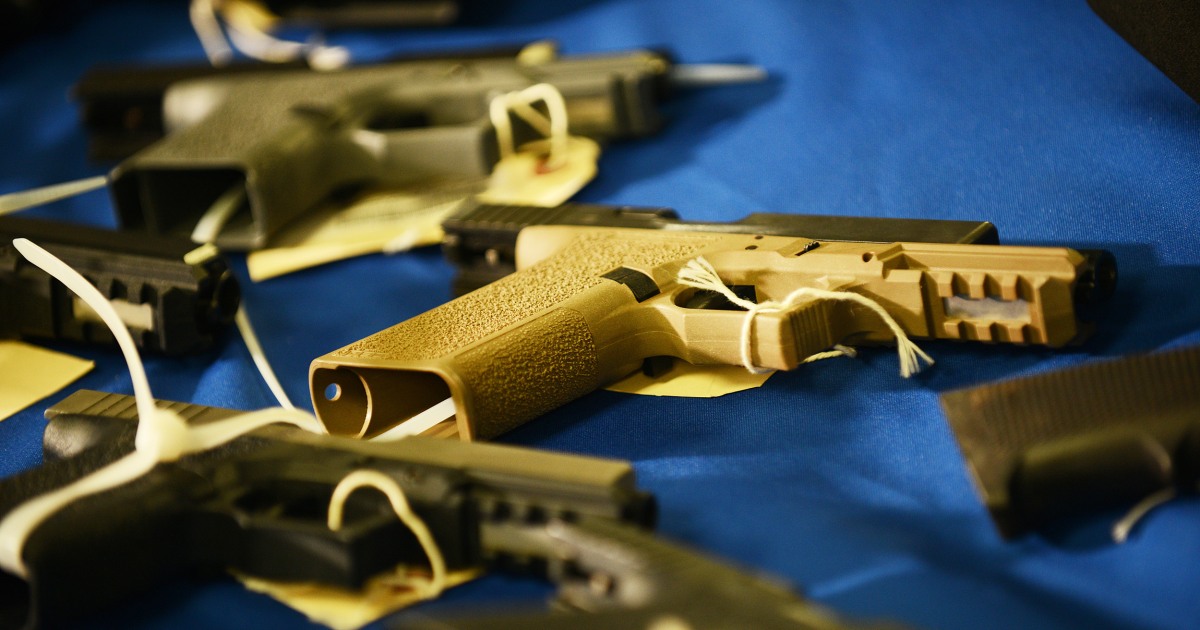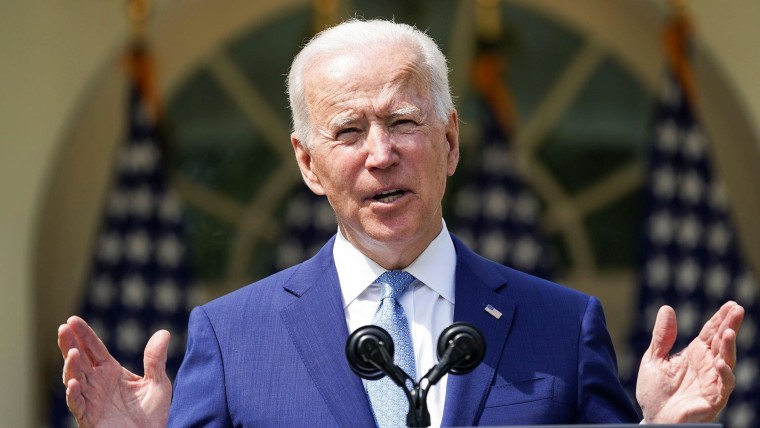WASHINGTON — The man who shot and killed 10 people in Boulder, Colorado, last month used a stabilizing brace for his semi-automatic pistol, which makes a weapon more accurate. One of the executive actions President Joe Biden announced to curb gun violence could make it more difficult to obtain such accessories.
The move was one of several executive actions Biden rolled out last week, which he signaled he would pursue in the wake of the shootings in Boulder and the Atlanta area last month.
Gun violence experts and advocates pushing for tighter firearm restrictions say that Biden’s unilateral actions could lead to some reduction in gun violence but that congressional action would be needed for substantial changes — a prospect that appears dim in the closely divided Congress.
Gun violence has skyrocketed in recent years. The Gun Violence Archive, a nonprofit group that tracks gun violence in the U.S., found that more than 19,000 people died in gun homicides last year, the most in more than two decades, up by nearly 25 percent from 2019.
Ghost guns
Among his executive actions last week, Biden directed the Justice Department to propose a rule to curb the proliferation of so-called ghost guns, which can be built at home from kits to create working firearms without serial numbers, making them untraceable.
Experts say the guns are becoming more popular among militia groups, such as members of the far-right boogaloo movement, and street gangs, such as the Latin Kings, because their parts can be purchased without federal background checks. And law enforcement officials are finding that more of the homemade firearms are being used in crimes in major cities, such as Los Angeles, Baltimore and Washington, D.C.
In 2019, a teenage gunman who shot five students, killing two of them, at a high school in Santa Clarita, California, used a .45-caliber semi-automatic pistol assembled from parts. In March of last year, a San Diego man was arrested for boarding an international flight to London with a Glock 19 replica ghost gun, loaded with nearly a dozen 9 mm rounds of ammunition, in the bottom of his carry-on bag. And in November, a convicted felon from Baltimore was sentenced to 21 years in federal prison for 10 armed robberies of banks and liquor stores — in two of which a ghost gun was used.
Because the guns are untraceable, there are no comprehensive data about their use. The gun control advocacy group Everytown for Gun Safety says that until police departments can track the weapons, criminal prosecutions are the best indicator of their proliferation. In a review of 114 federal cases over the last decade, the group found that more than 2,500 ghost guns were connected to criminal activity.
Meanwhile, according to the Bureau of Alcohol, Tobacco, Firearms and Explosives, law enforcement agencies recovered about 10,000 ghost guns in 2019.
Everytown found that the number of states where online sellers of the gun parts are based grew from 12 in 2014 to 26 last year.
At the news conference announcing Biden’s actions, Attorney General Merrick Garland said the administration’s rule would most likely classify do-it-yourself gun kits as firearms so they could be regulated under federal law, which experts say could go a long way toward reining in their use.
Daniel Webster, director of the Johns Hopkins Center for Gun Violence Prevention and Policy, said that if authorities “don’t act swiftly, I think it is going to really elevate rates of a number of forms of gun violence — both urban gun violence as well as potential more politically driven, basically, domestic terrorism. I think it’s a very significant and important move that will have an impact. It’ll enhance our public safety.”
Red flag laws
Biden also directed the Justice Department to develop legislation that states could use as a model for “red flag” laws, which allow police or family members to petition state courts to temporarily take firearms from those who present a danger to themselves or others.
Nineteen states and Washington, D.C., have passed such laws, according to Everytown; 14 did so after the 2018 mass shooting at a high school in Parkland, Florida, that left 17 people dead. Some experts have said such a law in Florida could have helped prevent the shooting because the FBI had been warned about the gunman’s increasingly alarming statements, but the information was never acted upon.
And some research has found that the laws can reduce gun violence. A study in 2018 found that suicides in Connecticut dropped by about 1.6 percent after the state enacted its first-in-the-nation red flag law in 1999 and then by 13.7 percent in the period following the mass shooting at Virginia Tech in 2007, when the law became more stringently enforced. The same study found that Indiana’s law, which was passed in 2005, caused a 7.5 percent decrease in firearm-related suicides in the decade after it was implemented.
The available evidence suggests that red flag laws “may have a positive impact on suicide prevention,” the Federal Commission on School Safety said in a 2018 report. “We do not know whether they impact gun violence more generally.”
Some Republicans, including Sens. Marco Rubio and Rick Scott of Florida, have expressed support for red flag laws. They recently reintroduced a bill with Sens. Jack Reed, D-R.I., and Angus King, I-Maine, that would make federal funding available to states to implement such laws, but it’s unclear whether the measure, which has faced opposition from some gun rights advocates, has any chance of advancing in the closely divided Congress.
The National Rifle Association has also made it clear that it opposes Biden’s actions, tweeting that they “could require law-abiding citizens to surrender lawful property, and push states to expand gun confiscation orders,” and saying the NRA “is ready to fight.”
A move that could have a big effect, some experts say, is the Biden administration’s prioritization of community violence intervention and prevention programs. The executive action directs five federal agencies to make changes to 26 programs that support and fund such programs.
One such initiative is Project Safe Neighborhoods, which the Justice Department launched in 2001 and bolstered in 2017. An annual report from October found that the initiative “successfully reduced violent crime by an average of 4–20 percent, with reductions as high as 42 percent in certain locations.”
Biden’s effort to “get federal agencies to provide more money for violence intervention programs seems promising,” said Jens Ludwig, a University of Chicago economist who studies gun violence. “It’s clear there is a real need for additional violence-prevention efforts that don’t rely solely on the criminal justice system, and resources have historically been a major barrier to doing that.”
Biden’s infrastructure plan would allocate $5 billion toward those programs.
Another of his executive actions instructs the Justice Department to issue a report on firearms trafficking, which Ludwig said could better illuminate the patterns of guns’ crossing state lines. Garland said the last such study was conducted more than 20 years ago.
Congressional inaction
While Biden’s actions could chip away at gun violence, experts say it won’t decrease dramatically unless Congress closes gaps in existing law, such as the “gun show loophole,” which exempts private sellers from performing federally required background check on buyers. Another, the “Charleston loophole,” allows a firearms sale to proceed if a background check isn’t completed within three days, which is how the gunman in the 2015 mass shooting at Emanuel African Methodist Episcopal Church in Charleston, South Carolina, is believed to have obtained his weapon.
“There’s still a long way to go,” said Louis Klarevas, a research professor of global affairs at Teachers College, Columbia University, who studies gun violence and has written about mass shootings. “What will really make a difference will be if he can get legislative measures enacted with the help with Congress. What he did today was strictly limited to what he can do from the White House in the executive branch.”
Sen. Chris Murphy, D-Conn., said he is talking to colleagues in both parties about expanding background checks, and the House passed a pair of measures this year that would do just that. But, as in years past, the prospect of passing such legislation appears limited, requiring Democrats in the evenly split Senate to hold on to the support of all 50 members of the party and gain the backing of 10 Republicans. House Democrats are also grappling with an extremely slim margin to advance legislation.
The last time Congress was anywhere near passing major gun legislation was in 2013, when the Senate fell six votes short of advancing a bill by Joe Manchin, D-W.Va., and Pat Toomey, R-Pa., that would have required background checks in all commercial gun sales.
“Ending gun violence can’t solely be addressed through executive action,” Shannon Watts, founder of Moms Demand Action, said last week. “That’s why Congress has to act on gun safety. It has been 25 years since our national leaders passed a federal gun safety law. That’s 25 years of survivors mourning their loved ones.”


